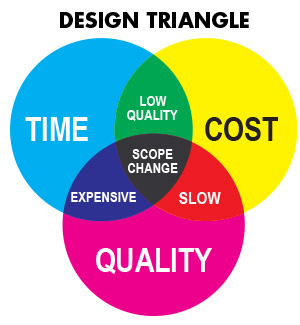Everyone wants the best quality design as quickly as possible. For which a quick turnaround is necessary, sometimes, it’s easy to forget that quality doesn’t always happen quickly. Without proper time to fully develop an idea, you might have something visually stunning, for sure. However, you may miss out on any deeper meaning or branding significance by forcing a design to happen too quickly.

Sometimes it’s best to give a visual. Think of the Quality-Cost-Time dynamics. While the three aspects have overlapping portions, it’s not possible to have all three in the same design. This is why you’re meant to consider the triangle and pick two. For example, fast, great, and cheap is simply not a reality. However, many times it’s difficult for many businesses to understand when push becomes shove.
If your marketing team finds themselves in a time crunch predicament, where a design needs to happen as fast as possible, you’ll need to ask yourself that which is more important: quick turnaround, cost, or the quality. Rank them in order and realize that this is the dynamics to expect from your designer. Express your desires in order of importance, so that they can quote you appropriately. Not only does this mean finding the time to rearrange schedules, if necessary—but also to find the right designer who fits your company’s prioritization needs.
The Importance of Time
The concept of time as it relates to design work is actually twofold. It can either mean the time it takes to do the design itself, or the experience that the designer has. Both are equally important, and we’ll explain why.
- Time for Brainstorming
New designers who are naturally talented may be able to come up with a good design quickly. But don’t mistake good for great. Often, stupendous designers come in the form of a talented team who are each genius in their area of expertise. When they come together and brainstorm, that’s where the magic happens. But this isn’t always a quick process. Sometimes it requires research, and prototyping before a final project comes to completion. Of course, incorporating this measure of time means that the finished piece won’t happen quickly, and therefore negates the quick turnaround. - Time for Absorption (Experience)
On the other hand, becoming an experienced designer obviously takes time. In general, it is a process of years of practice and honing of skills, and taking advanced classes. Continuing education is relentless for designers because they include continuing to learn both design concepts and keep up with programs as they evolve. There are many layers to design, so the deeper the designer has delved, the more quality they bring to everything they do. The good news is, for these designers, quality designs can happen quicker than most because they’ve got the skills and knowledge to make it happen. But this kind of quick turnaround quality is also more expensive, and you should expect this if you want to utilize their experience.
The Importance of Quality
In some ways, the concept of quality is there in the eyes of the beholder. Some businesses are searching for a design that only looks good, while others expect a piece with third read nuances. Determination of the level of quality that your company needs can help you direct to a more affordable and often quicker solution. The key is being able to communicate those needs and hire a designer with the kind of skills you’re looking for.
The Importance of Cost
Again, the concept of cost is similar to that of time because its dynamics is two-fold. It can mean tight budget constrictions and have to consider carefully how each dollar is spent, or it can mean the value that the design brings to the overall brand. Both should be considered concerning the other two elements. Let’s take a look:
- Budget Costs
Every business has a budget they need to work within. It’s reasonable to place a certain amount of importance on the bottom dollar. This alone can set the tone for determining the priority of relevance with the other two elements of time and quality. Know what your company can afford before setting unreasonable or unattainable goals for both the design and the designer. - Value to Brand
The other side of cost is the hidden aspect that many forget to look closer. Design quality often comes with a more expensive price tag, but it includes many perks along with it. One such perk is the value it lends to the brand itself. Through giving a design or idea, the proper amount of time to develop or by rewarding a particular designer’s years of experience, you’re actually creating authority and relevance to your company. A well thought out design can bring value to your business in a variety of ways from drawing recognition, pulling potential customers, and even keeping people talking for years to come. This, in turn, pays many folds and thus, design is considered as an investment and not an expense.
What this, all comes down to: While quality design can certainly be quick, it will come with a heftier price tag because it means the caliber of the designer must go up. However, that doesn’t mean all quality designs should be treated equally, or every great design costs a fortune. It does, however, suggest setting the realistic expectations for all involved and drawing upon the Design Triangle to guide you.
– Artwork Abode



